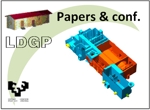Model of sources: a proposal for the hierarchy, merging strategy and representation of the information sources in virtual models of historical buildings
FERNANDO DE FUENTES, Andrés. VALLE MELÓN, José Manuel. RODRÍGUEZ MIRANDA, Álvaro. "Model of sources: a proposal for the hierarchy, merging strategy and representation of the information sources in virtual models of historical buildings". In: Fusion of Cultures. XXXVIII Annual Conference on Computer Applications and Quantitative Methods in Archaeology – CAA2010. 2010. pp. 507-510
Laburpena
[EN] Virtual models show an image of the historical buildings for a specific moment in
time and with a definite level of detail. Many information sources are normally
required to build up a virtual model, some common examples are: remains, metric documents, descriptions or hypothesis. Not all the sources are equal in certainty or completeness and we will seldom have at our disposal exhaustive, reliable and well-dated sources for every part and detail. In addition, any virtual model which is not complete it is not evocative either,
consequently, it will be necessary to resort to partial, doubtful or out-of-date
information to complete it. This paper is not focused on how to build up the model but on two collateral aspects
sometimes neglected: Firstly, which selection criteria we will use to prioritise the sources when an element appears in more than one of them, either in a coincident
or in a contradictory way and, secondly, how to represent graphically the differences
between the sources. [ES] Los modelos virtuales presentan una imagen de los edificios históricos para un
momento determinado en el tiempo y con un nivel de detalle definido. Generalmente, es necesario recurrir a varias fuentes de información para construir los modelos, por ejemplo: restos, documentos métricos, descripciones o hipótesis. No todas las fuentes son iguales en cuanto a certeza o exhaustividad y rara vez se dispondrá de datos fiables y bien datados para la totalidad del modelo, sin embargo, el modelo debe ser completo para ser evocativo lo que nos puede obligar a recurrir a información dudosa o fuera de fecha para completarlo.
Este texto se centra en dos aspectos que no suelen tratarse con detalle en la
generación de modelos virtuales: en primer lugar, qué criterio de selección aplicar
cuando se debe decidir entre varias fuentes de información para representar un
determinado objeto (bien si ambas fuentes son coincidentes, bien cuando se contradicen) y, en segundo lugar, cómo representar gráficamente las diferencias
entre las fuentes.
 Itzuli
Itzuli

